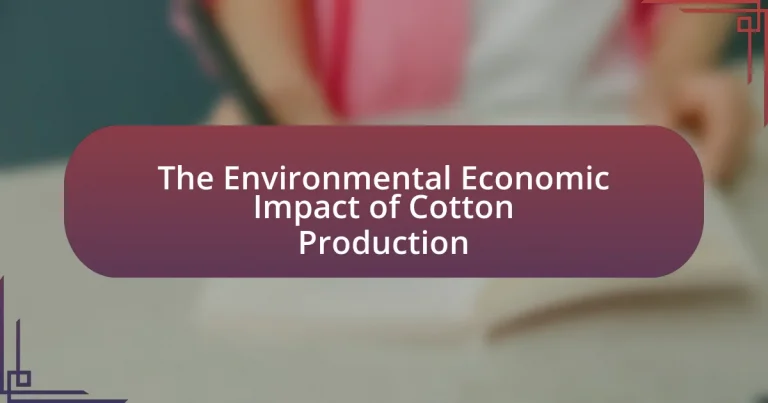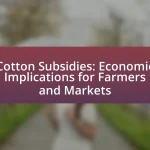The article examines the environmental economic impact of cotton production, highlighting its significant water usage, pesticide application, and soil degradation. Cotton farming accounts for approximately 2.6% of global water use and 24% of global insecticide use, leading to water scarcity and biodiversity loss. The economic implications include increased costs for farmers due to resource depletion and health issues related to pesticide exposure. Additionally, the article discusses the role of cotton in local economies, global trade, and the potential benefits of sustainable practices that can enhance profitability while mitigating environmental harm.
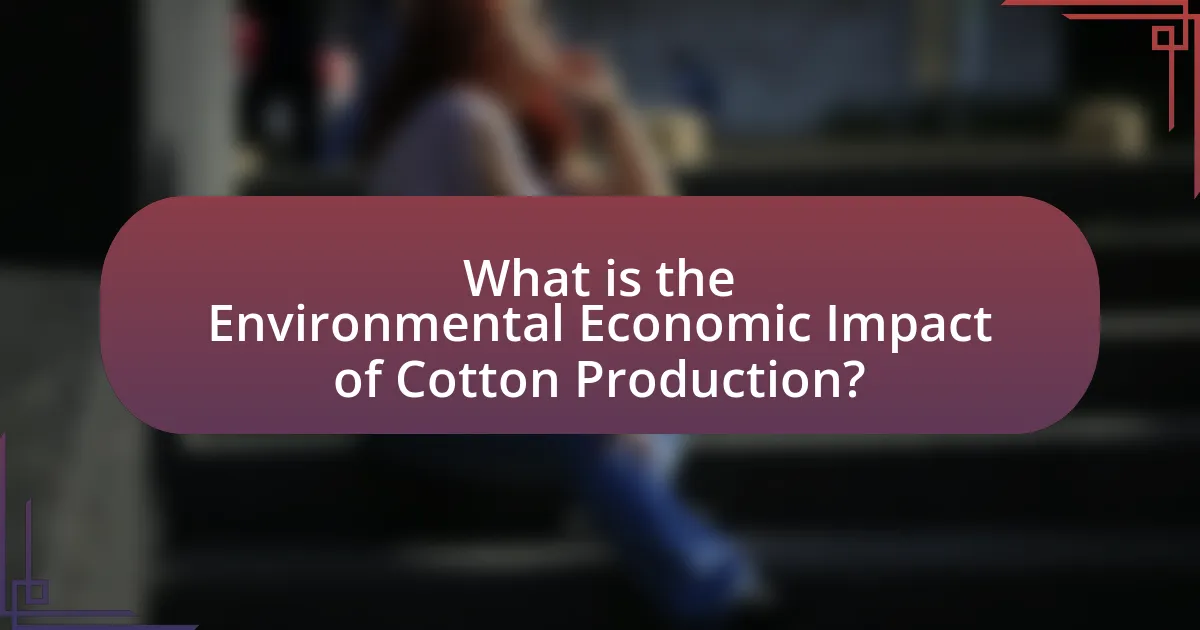
What is the Environmental Economic Impact of Cotton Production?
The environmental economic impact of cotton production is significant, primarily due to its high water usage and pesticide application. Cotton cultivation accounts for approximately 2.6% of global water use, leading to water scarcity in many regions. Additionally, the use of pesticides in cotton farming contributes to soil degradation and biodiversity loss, with studies indicating that cotton production uses around 16% of the world’s insecticides. These environmental costs translate into economic implications, as the depletion of natural resources and ecosystem services can lead to increased costs for farmers and communities reliant on these ecosystems. Furthermore, the economic burden of health issues related to pesticide exposure can strain public health systems, highlighting the interconnectedness of environmental and economic factors in cotton production.
How does cotton production affect the environment?
Cotton production significantly affects the environment through high water consumption, pesticide use, and soil degradation. The cultivation of cotton requires approximately 7,000 liters of water to produce just one kilogram of cotton, leading to water scarcity in regions where it is grown. Additionally, cotton farming often relies on harmful pesticides; for instance, cotton accounts for about 24% of global insecticide use, which can harm biodiversity and contaminate water sources. Furthermore, intensive cotton farming practices can lead to soil erosion and nutrient depletion, reducing soil fertility over time. These environmental impacts highlight the need for sustainable practices in cotton production to mitigate adverse effects.
What are the primary environmental concerns associated with cotton farming?
The primary environmental concerns associated with cotton farming include excessive water usage, pesticide and chemical runoff, and soil degradation. Cotton cultivation is highly water-intensive, with estimates indicating that it requires approximately 7,000 to 29,000 liters of water to produce just one kilogram of cotton, leading to significant depletion of freshwater resources. Additionally, the use of synthetic pesticides and fertilizers in cotton farming contributes to soil and water contamination, harming local ecosystems and biodiversity. Soil degradation occurs due to monoculture practices, which reduce soil fertility and increase vulnerability to erosion. These factors collectively highlight the environmental impact of cotton production on ecosystems and water resources.
How does cotton production contribute to soil degradation?
Cotton production contributes to soil degradation primarily through the depletion of soil nutrients and increased erosion. The intensive farming practices associated with cotton cultivation, such as monocropping and heavy use of chemical fertilizers and pesticides, lead to a decline in soil fertility. Research indicates that cotton farming can reduce organic matter in the soil by up to 50%, which is crucial for maintaining soil health. Additionally, the lack of crop rotation and cover crops exacerbates soil erosion, with studies showing that cotton fields can lose significant topsoil, leading to long-term degradation of the land.
What economic factors are influenced by cotton production?
Cotton production influences several economic factors, including employment, export revenues, and agricultural pricing. Employment is significantly impacted as cotton farming creates jobs in rural areas, with millions of people engaged in cultivation, processing, and distribution. Export revenues are also affected, as cotton is a major cash crop for many countries, contributing billions to national economies; for instance, in 2021, the global cotton trade was valued at approximately $50 billion. Additionally, agricultural pricing is influenced by cotton production, as fluctuations in supply can affect market prices, impacting farmers’ income and consumer costs. These factors collectively demonstrate the substantial economic impact of cotton production on both local and global scales.
How does cotton production impact local economies?
Cotton production significantly impacts local economies by providing employment opportunities and generating income for farmers and workers. In regions where cotton is a primary crop, such as the United States and India, it creates millions of jobs in farming, processing, and distribution. For instance, in the U.S., the cotton industry contributes approximately $21 billion to the economy annually, supporting over 200,000 jobs. Additionally, cotton production stimulates local businesses, including suppliers of seeds, fertilizers, and machinery, further enhancing economic activity. The reliance on cotton also leads to increased investment in infrastructure and services in rural areas, fostering overall economic development.
What role does cotton play in global trade and markets?
Cotton plays a crucial role in global trade and markets as one of the most widely traded agricultural commodities, significantly impacting economies and employment worldwide. In 2021, global cotton production reached approximately 25 million metric tons, with major producers including China, India, and the United States, which collectively account for over 60% of total production. The International Cotton Advisory Committee reports that cotton contributes around $200 billion annually to the global economy, influencing trade balances and providing livelihoods for millions of farmers and workers in the textile industry. Additionally, cotton’s integration into various supply chains highlights its importance in international trade, as it is a key raw material for the apparel and home textiles sectors, which are valued at over $1 trillion globally.
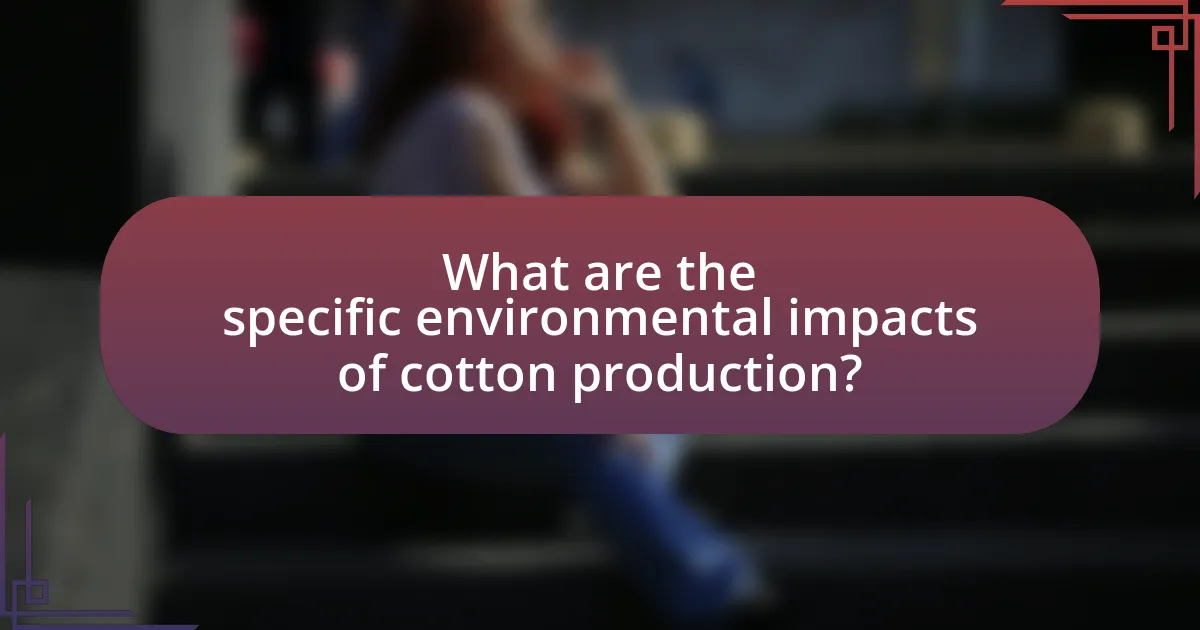
What are the specific environmental impacts of cotton production?
Cotton production has significant environmental impacts, primarily through water consumption, pesticide use, and soil degradation. The cultivation of cotton requires large amounts of water; for instance, it takes approximately 7,000 liters of water to produce just one kilogram of cotton. This high water demand can lead to the depletion of local water resources, affecting ecosystems and communities. Additionally, cotton farming often relies heavily on pesticides and fertilizers, which can contaminate soil and water sources, harming biodiversity and human health. Studies indicate that cotton accounts for about 24% of global insecticide use, contributing to the decline of beneficial insect populations. Furthermore, the intensive farming practices associated with cotton can lead to soil erosion and degradation, reducing soil fertility over time. These factors collectively illustrate the substantial environmental challenges posed by cotton production.
How does water usage in cotton farming affect ecosystems?
Water usage in cotton farming significantly impacts ecosystems by depleting local water resources and altering habitats. The high water demand of cotton, which can require up to 20,000 liters per kilogram of fiber, leads to reduced water availability for other plants and animals in the area. This over-extraction can result in the degradation of wetlands and rivers, affecting biodiversity and disrupting the balance of local ecosystems. Additionally, the runoff from cotton fields, often laden with pesticides and fertilizers, can contaminate nearby water bodies, further harming aquatic life and reducing water quality. Studies have shown that regions heavily reliant on cotton farming experience a decline in native species and an increase in invasive species, which can outcompete local flora and fauna.
What are the implications of pesticide use in cotton cultivation?
Pesticide use in cotton cultivation leads to significant environmental and economic implications. Environmentally, pesticides can contaminate soil and water, harming non-target organisms and disrupting ecosystems. For instance, studies indicate that pesticide runoff can lead to the decline of aquatic life in nearby water bodies, affecting biodiversity. Economically, while pesticides may initially increase cotton yields, the long-term costs include health impacts on farmworkers and communities, as well as potential loss of market access due to stricter regulations on pesticide residues. Research shows that the economic burden of health issues related to pesticide exposure can outweigh the short-term financial benefits of increased production.
How does cotton production contribute to biodiversity loss?
Cotton production contributes to biodiversity loss primarily through habitat destruction, pesticide use, and monoculture practices. The expansion of cotton farming often leads to the clearing of diverse ecosystems, such as forests and wetlands, which displaces numerous species. Additionally, the heavy application of pesticides in cotton cultivation not only targets pests but also harms non-target organisms, including beneficial insects and wildlife. Monoculture, the practice of growing a single crop over a large area, reduces genetic diversity and disrupts local ecosystems, making them more vulnerable to pests and diseases. According to the Food and Agriculture Organization, cotton farming has been linked to significant declines in species richness in agricultural landscapes, highlighting its detrimental impact on biodiversity.
What are the carbon emissions associated with cotton production?
The carbon emissions associated with cotton production are approximately 1.8 kilograms of CO2 equivalent per kilogram of cotton produced. This figure encompasses emissions from various stages of production, including land use change, fertilizer application, and energy consumption during processing. According to a study published in the journal “Environmental Science & Technology,” cotton cultivation contributes significantly to greenhouse gas emissions, primarily due to the extensive use of synthetic fertilizers and pesticides, which release nitrous oxide, a potent greenhouse gas. Additionally, the energy-intensive nature of irrigation and machinery further exacerbates the carbon footprint of cotton production.
How does transportation of cotton affect its carbon footprint?
Transportation of cotton significantly increases its carbon footprint due to the emissions generated from various modes of transport. The carbon footprint is influenced by the distance cotton is transported, the type of transportation used, and the efficiency of the logistics involved. For instance, transporting cotton over long distances by truck or ship can result in substantial greenhouse gas emissions; studies indicate that road transport can emit approximately 0.1 to 0.2 kg of CO2 per ton-kilometer. Additionally, the use of air freight, while faster, has a much higher carbon intensity, emitting around 1.5 kg of CO2 per ton-kilometer. Therefore, the transportation phase of cotton production plays a critical role in determining its overall environmental impact, contributing to the total carbon emissions associated with cotton products.
What measures can be taken to reduce carbon emissions in cotton production?
To reduce carbon emissions in cotton production, implementing sustainable agricultural practices is essential. These practices include adopting no-till farming, which minimizes soil disturbance and enhances carbon sequestration, and utilizing cover crops to improve soil health and reduce erosion. Additionally, integrating precision agriculture technologies can optimize resource use, thereby decreasing emissions associated with fertilizer and water application. Research indicates that these methods can lead to a significant reduction in greenhouse gas emissions, with studies showing that no-till practices can reduce carbon emissions by up to 30% compared to conventional tillage methods.
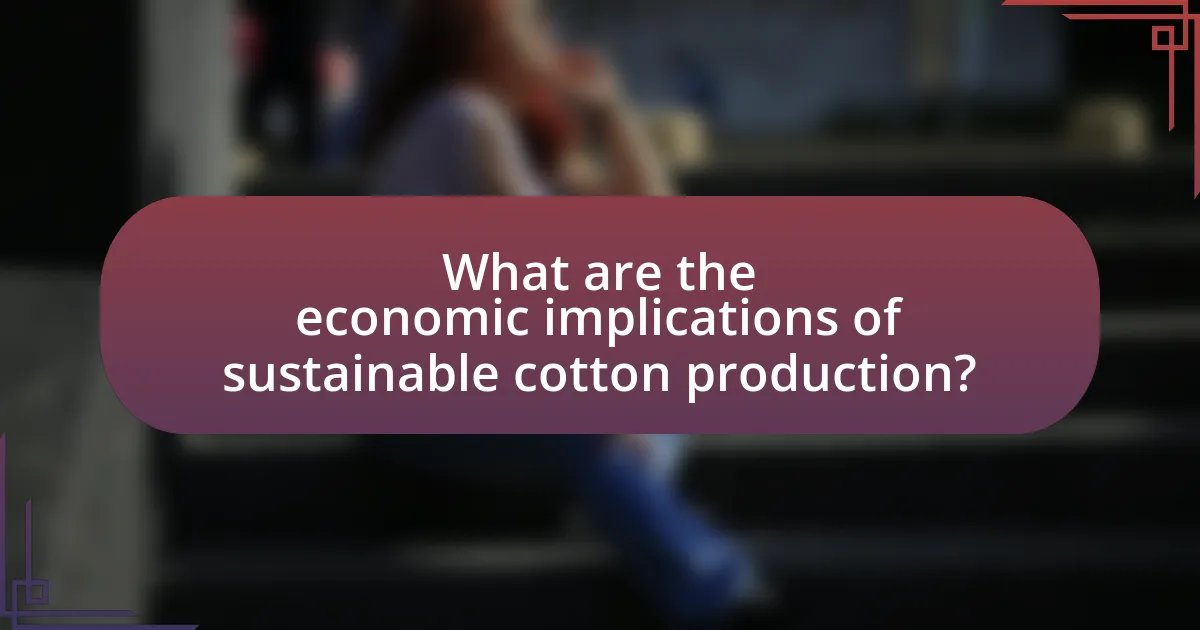
What are the economic implications of sustainable cotton production?
Sustainable cotton production has significant economic implications, including increased profitability for farmers and reduced costs associated with environmental degradation. By adopting sustainable practices, farmers can enhance soil health and reduce reliance on chemical inputs, leading to lower production costs. Research indicates that sustainable cotton farming can yield higher prices in the market, as consumers increasingly prefer ethically produced goods. For instance, a study by the International Cotton Advisory Committee found that sustainable cotton can command a price premium of 10-30% compared to conventional cotton. Additionally, sustainable practices can lead to improved resilience against climate change, ultimately safeguarding farmers’ incomes and contributing to long-term economic stability in cotton-producing regions.
How can sustainable practices in cotton farming benefit the economy?
Sustainable practices in cotton farming can significantly benefit the economy by reducing costs and increasing profitability for farmers. Implementing techniques such as crop rotation, organic fertilizers, and integrated pest management can lower input costs and enhance soil health, leading to higher yields. For instance, a study by the World Bank found that sustainable cotton farming can increase farmers’ income by up to 30% due to reduced reliance on chemical inputs and improved market access for organic cotton. Additionally, sustainable practices can create jobs in rural areas, contributing to local economies and fostering community development.
What are the cost benefits of adopting organic cotton farming?
Adopting organic cotton farming offers significant cost benefits, primarily through reduced input costs and increased market prices. Organic cotton farming eliminates the need for synthetic fertilizers and pesticides, which can account for a substantial portion of conventional farming expenses. According to a study by the Research Institute of Organic Agriculture, organic cotton farmers can save up to 30% on input costs compared to their conventional counterparts. Additionally, organic cotton typically commands a premium price in the market, with prices often 20-50% higher than conventional cotton, as consumers increasingly demand sustainable products. This combination of lower costs and higher selling prices enhances the overall profitability of organic cotton farming.
How does consumer demand for sustainable cotton impact prices?
Consumer demand for sustainable cotton generally leads to higher prices due to increased production costs and limited supply. As consumers become more environmentally conscious, they are willing to pay a premium for sustainably produced cotton, which incentivizes farmers to adopt sustainable practices. According to a 2021 report by the Textile Exchange, the global market for organic cotton reached approximately $1.5 billion, reflecting a growing willingness to invest in sustainable options. This shift in consumer preference drives up demand, which, combined with the often higher costs associated with sustainable farming methods, results in elevated market prices for sustainable cotton compared to conventional cotton.
What policies can support the economic viability of sustainable cotton production?
Policies that can support the economic viability of sustainable cotton production include financial incentives, regulatory frameworks, and market access initiatives. Financial incentives, such as subsidies for sustainable farming practices and grants for technology adoption, can lower production costs and encourage farmers to transition to sustainable methods. Regulatory frameworks that promote environmental standards and certifications, like organic or Fair Trade labels, can enhance marketability and consumer trust. Additionally, initiatives that improve market access, such as trade agreements favoring sustainably produced cotton, can increase demand and profitability for farmers engaged in sustainable practices. These policies collectively create a supportive environment that fosters the economic sustainability of cotton production while addressing environmental concerns.
How do subsidies influence sustainable cotton farming practices?
Subsidies significantly influence sustainable cotton farming practices by providing financial support that encourages farmers to adopt environmentally friendly methods. These financial incentives can lower the cost of implementing sustainable practices, such as organic farming, integrated pest management, and water conservation techniques. For instance, a study by the International Cotton Advisory Committee found that countries offering subsidies for sustainable practices saw a 20% increase in the adoption of eco-friendly farming methods among cotton producers. This demonstrates that subsidies can effectively promote sustainability in cotton farming by making it economically viable for farmers to transition from conventional to sustainable practices.
What role do certifications play in promoting sustainable cotton production?
Certifications play a crucial role in promoting sustainable cotton production by establishing standards that ensure environmentally friendly practices and social responsibility. These certifications, such as Global Organic Textile Standard (GOTS) and Better Cotton Initiative (BCI), require adherence to specific criteria that limit pesticide use, promote water conservation, and ensure fair labor practices. For instance, GOTS-certified cotton must meet stringent ecological and social criteria, which helps reduce the environmental footprint of cotton farming. Additionally, the presence of these certifications can enhance market access and consumer trust, as buyers increasingly prefer sustainably sourced products. This shift is supported by data indicating that certified cotton can lead to improved yields and reduced input costs for farmers, thereby promoting both environmental sustainability and economic viability in the cotton industry.
What are best practices for reducing the environmental impact of cotton production?
Best practices for reducing the environmental impact of cotton production include implementing organic farming techniques, utilizing water-efficient irrigation methods, and adopting integrated pest management. Organic farming techniques minimize chemical use, which reduces soil and water pollution; for instance, organic cotton farming has been shown to decrease pesticide use by up to 90%. Water-efficient irrigation methods, such as drip irrigation, can reduce water consumption by 30-50%, addressing the significant water footprint of cotton cultivation. Integrated pest management combines biological, cultural, and chemical practices to control pests sustainably, leading to a reduction in harmful pesticide applications. These practices collectively contribute to a more sustainable cotton production system, mitigating its environmental impact.
